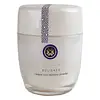What's inside
What's inside
 Key Ingredients
Key Ingredients

 Benefits
Benefits

 Concerns
Concerns

 Ingredients Side-by-side
Ingredients Side-by-side

Microcrystalline Cellulose
AbsorbentOryza Sativa Powder
Sodium Lauryl Phosphate
EmulsifyingSodium Palmoyl Glutamate
CleansingSodium Lauroyl Glutamate
Lauryl Betaine
CleansingSodium Lauroyl Methylaminopropionate
CleansingCamellia Sinensis Leaf
PerfumingPapain
Skin ConditioningOryza Sativa Bran
AbrasiveSericin
Skin ConditioningHydrolyzed Silk
HumectantPropanediol
SolventDextrin
AbsorbentPhytosteryl/Octyldodecyl Lauroyl Glutamate
Skin ConditioningEthylhexylglycerin
Skin ConditioningTocopherol
AntioxidantPropyl Alcohol
SolventAlcohol
AntimicrobialPhenoxyethanol
PreservativeMicrocrystalline Cellulose, Oryza Sativa Powder, Sodium Lauryl Phosphate, Sodium Palmoyl Glutamate, Sodium Lauroyl Glutamate, Lauryl Betaine, Sodium Lauroyl Methylaminopropionate, Camellia Sinensis Leaf, Papain, Oryza Sativa Bran, Sericin, Hydrolyzed Silk, Propanediol, Dextrin, Phytosteryl/Octyldodecyl Lauroyl Glutamate, Ethylhexylglycerin, Tocopherol, Propyl Alcohol, Alcohol, Phenoxyethanol
Water
Skin ConditioningGlycerin
HumectantCocamidopropyl Betaine
CleansingCoco-Glucoside
CleansingSodium Lauroyl Methyl Isethionate
CleansingCocamidopropyl Hydroxysultaine
CleansingSodium Methyl Oleoyl Taurate
CleansingPropanediol
SolventAloe Barbadensis Leaf Extract
EmollientGlycolipids
Skin ConditioningLinoleic Acid
CleansingLinolenic Acid
CleansingLauryl Glucoside
CleansingCucumis Melo Cantalupensis Fruit Extract
AstringentSclerocarya Birrea Seed Oil
HumectantDipotassium Glycyrrhizate
HumectantTocopherol
AntioxidantCitric Acid
BufferingPhenoxyethanol
PreservativeSodium Hydroxide
BufferingSodium Benzoate
MaskingSodium Chloride
MaskingPolylysine
Water, Glycerin, Cocamidopropyl Betaine, Coco-Glucoside, Sodium Lauroyl Methyl Isethionate, Cocamidopropyl Hydroxysultaine, Sodium Methyl Oleoyl Taurate, Propanediol, Aloe Barbadensis Leaf Extract, Glycolipids, Linoleic Acid, Linolenic Acid, Lauryl Glucoside, Cucumis Melo Cantalupensis Fruit Extract, Sclerocarya Birrea Seed Oil, Dipotassium Glycyrrhizate, Tocopherol, Citric Acid, Phenoxyethanol, Sodium Hydroxide, Sodium Benzoate, Sodium Chloride, Polylysine
 Reviews
Reviews

Alternatives
Ingredients Explained
These ingredients are found in both products.
Ingredients higher up in an ingredient list are typically present in a larger amount.
Phenoxyethanol is a preservative that has germicide, antimicrobial, and aromatic properties. Studies show that phenoxyethanol can prevent microbial growth. By itself, it has a scent that is similar to that of a rose.
It's often used in formulations along with Caprylyl Glycol to preserve the shelf life of products.
Propanediol is an all-star ingredient. It softens, hydrates, and smooths the skin.
It’s often used to:
Propanediol is not likely to cause sensitivity and considered safe to use. It is derived from corn or petroleum with a clear color and no scent.
Learn more about PropanediolTocopherol (also known as Vitamin E) is a common antioxidant used to help protect the skin from free-radicals and strengthen the skin barrier. It's also fat soluble - this means our skin is great at absorbing it.
Vitamin E also helps keep your natural skin lipids healthy. Your lipid skin barrier naturally consists of lipids, ceramides, and fatty acids. Vitamin E offers extra protection for your skin’s lipid barrier, keeping your skin healthy and nourished.
Another benefit is a bit of UV protection. Vitamin E helps reduce the damage caused by UVB rays. (It should not replace your sunscreen). Combining it with Vitamin C can decrease sunburned cells and hyperpigmentation after UV exposure.
You might have noticed Vitamin E + C often paired together. This is because it is great at stabilizing Vitamin C. Using the two together helps increase the effectiveness of both ingredients.
There are often claims that Vitamin E can reduce/prevent scarring, but these claims haven't been confirmed by scientific research.
Learn more about Tocopherol